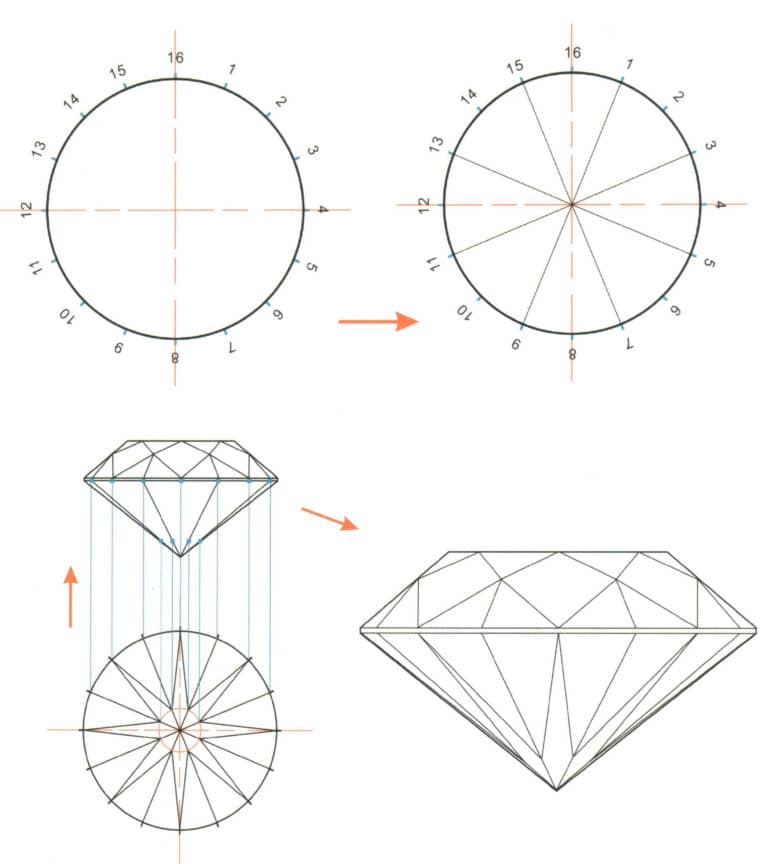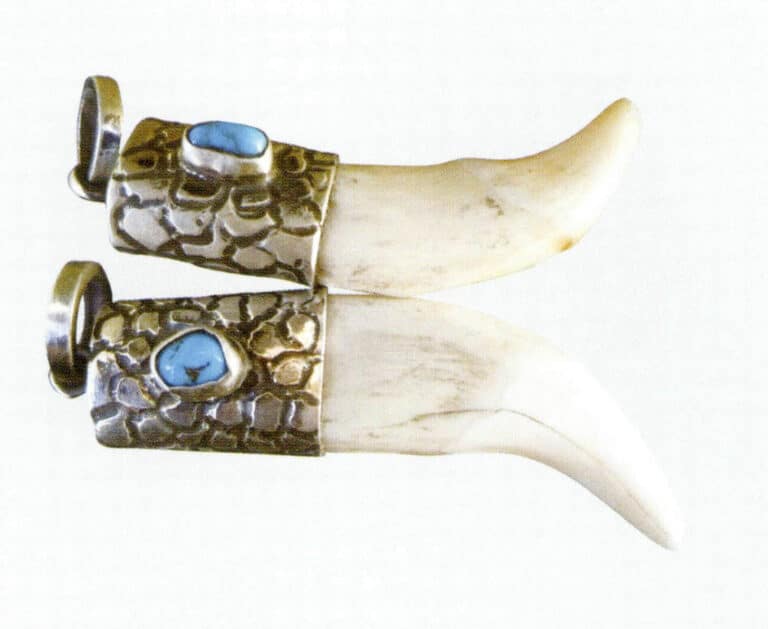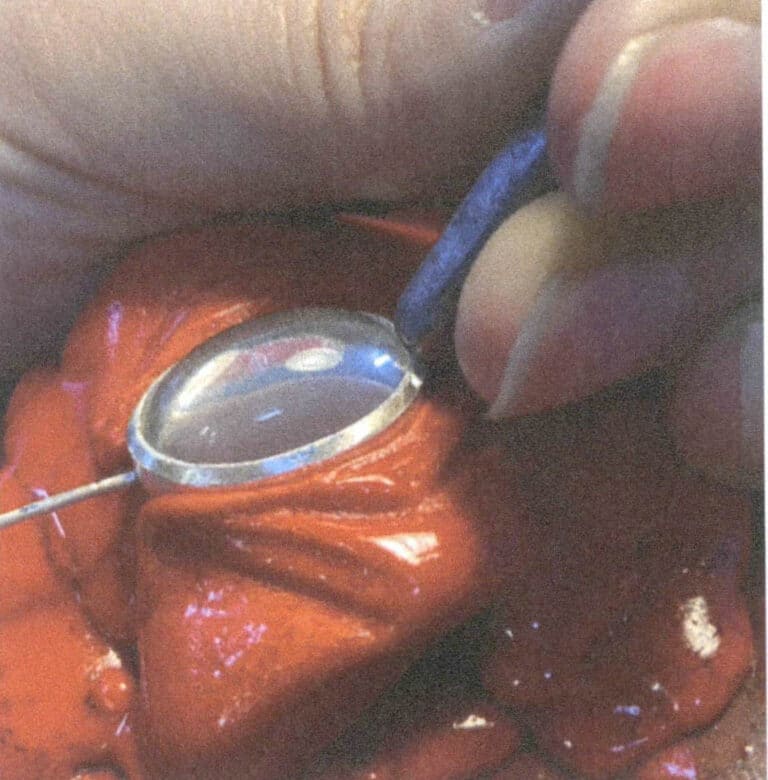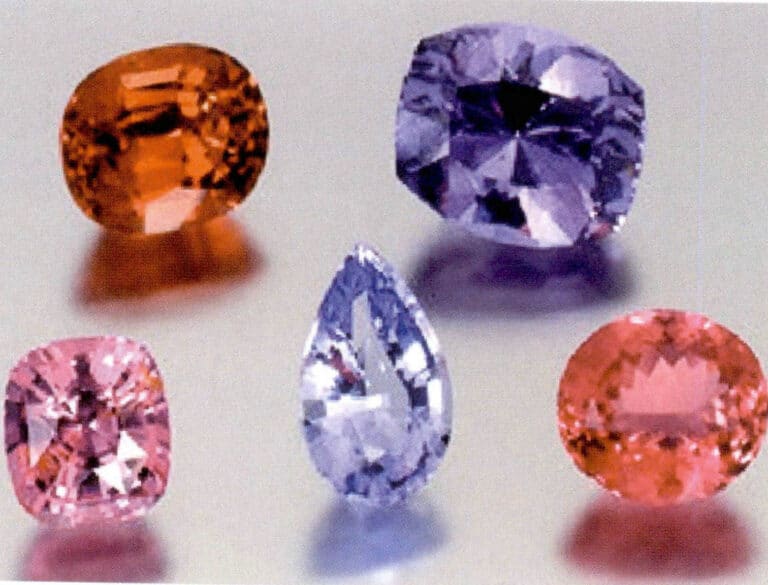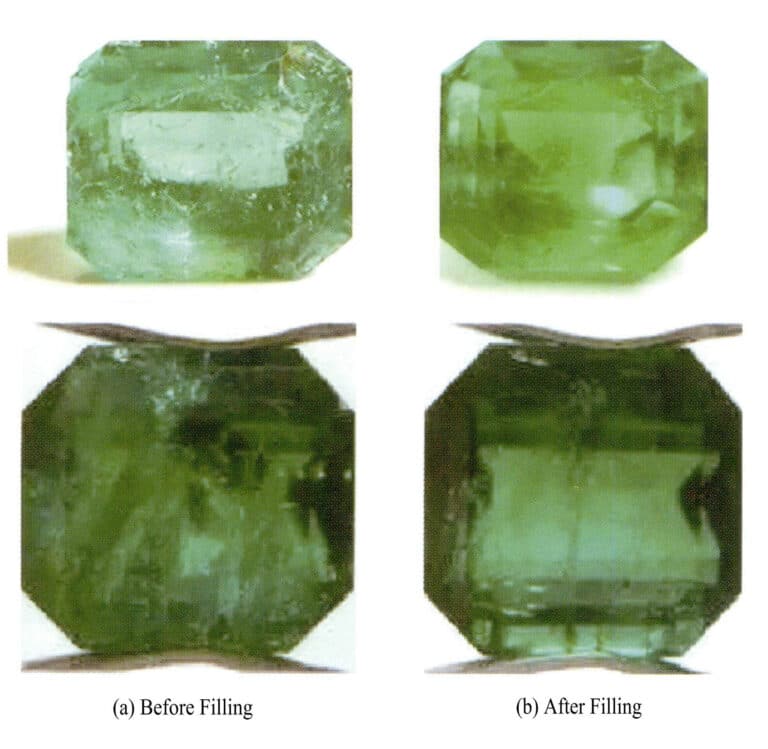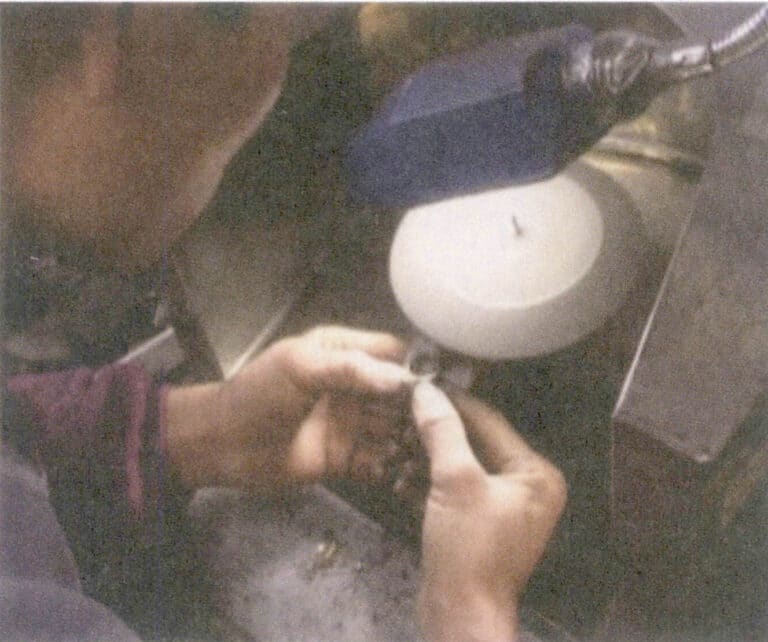Basic information of gemstones and jewelry used precious metal
A Deep Dive into gemstone classification, origin, jewelry hall mark and certification
The English word “Jewelry” comes from the Latin “Jocale,” meaning plaything. The English word “Jewel” derives from the French Jouel in the 13th century. Jewelry (also spelled as Jewellery in Europe) describes precious materials (gems, precious metals, etc.) used to adorn people.
Whether abroad or domestically, the terms jewelry and ornaments originally referred to precious materials used to adorn people. With the technological advancements and improvements in mineralogy and petrology in the 18th century, gemology gradually developed in response to market demand. The gems mentioned in gemology differ from traditional concepts, as their scope is broader. With the development of modern technology, more new materials continue to flood the market, but the requirements for gem materials still must meet beauty, durability, rarity, and processability.

Innehållsförteckning
Section ⅠDefinition and Classification of Gemstones
1. Definition of Gemstones
Gemstones refer to both natural and artificial gemstones, abbreviated as gems.
Traditionally, gemstones refer to crystals (Figure 1-1-1), aggregates, or organic gems (Figure 1-1-2) produced by nature that possess beauty, durability, rarity, and craftsmanship value, and can be processed into ornaments, such as diamonds and pearls. Therefore, when mentioning gemstones, their names are often equated with their prices, which are considered extremely expensive.
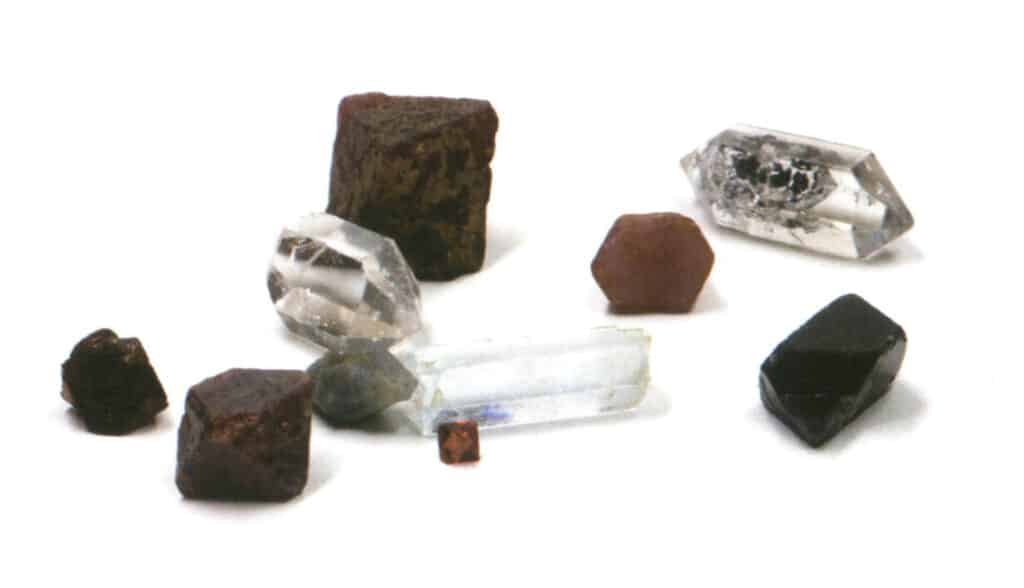
Bild 1-1-1 Kristall
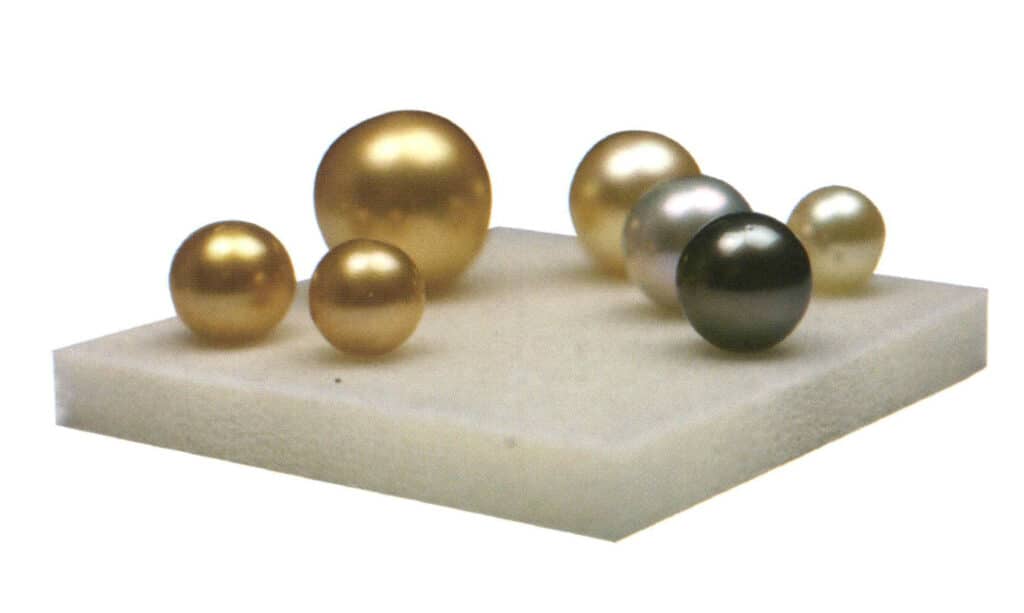
Figure 1-1-2 Pearl
With the continuous development of materials science, it has become easier to create gemstone materials in the laboratory, and more attention is paid to the beauty and processability of solid materials, such as glass and plastic, in various shapes and colors. These types of gemstones are usually considered fake or not gemstones at all.
More than 4,000 types of minerals have been discovered in nature, of which only about 230 can be used as gemstone materials. In comparison, the main popular gemstones in domestic and international jewelry markets are only about 50 types. In the market, not all popular gemstones possess the characteristics of beauty, rarity, durability, and processability simultaneously; some gemstones only have one or two outstanding features. For example, pearls are usually very attractive in color, but their hardness is very low, only 2.5~4.5.
2. Classification of Gemstones
The classification names in Table 1, “Jewelry and Jade – Names” also includes a category of jewelry that does not represent specific categories of gemstones.
Jade or other materials are called imitation gemstones, which mimic the color, optical phenomena, and other appearance characteristics of a certain type of natural gemstone.
Table 1: Classification of Gemstones
| Types and Definitions of Gemstones | Subcategories and Definitions of Gemstones | Examples of Gemstones |
|---|---|---|
| Natural Gemstones: Substances produced by nature that possess beauty, durability, rarity, and artistic value, which can be processed into ornaments. | Natural Gemstones: Single crystals of natural minerals that possess beauty, durability, and rarity can be processed into ornaments (may include twinning) | Diamonds, crystals, etc. |
| Natural jade: a mineral aggregate produced by nature, characterized by beauty, durability, rarity, and craftsmanship value, with a few being amorphous. | The aggregates include jadeite, nephrite, etc., while the amorphous ones include natural glass, opal, etc. | |
| Natural organic gemstones: are generated by living organisms in nature, composed partially or entirely of organic materials, and used as materials for jewelry and ornaments, with cultured pearls also belonging to this category. | Pearls, coral, etc | |
| Synthetic and artificial gemstones: Materials that are completely or partially produced or manufactured as jewelry and ornaments (excluding pure metal materials). | Synthetic stones: Crystals, amorphous solids, or aggregates that are completely or partially artificially manufactured and have known corresponding natural counterparts, with physical properties, chemical composition, and crystal structure essentially the same as those of the corresponding natural gemstones. | Synthetic diamonds, synthetic crystals, synthetic opals, synthetic jade, etc. |
| Artificial gemstones: Crystals, amorphous solids, or aggregates that are artificially manufactured and have no known natural counterparts. | Artificial brazed aluminum garnet, etc | |
| Composite stones: Jewelry made by manually combining two or more pieces of material, giving an overall impression. | Composite sapphires, composite diamonds, composite synthetic opals, etc. | |
| Reconstructed gemstones: Jewelry created by artificially melting or sintering fragments or debris of natural gemstones into a cohesive appearance. | Reconstructed amber, reconstructed turquoise, etc. |
In order to make it easier for beginners to understand, this article divides the three main categories of jewelry and jade, natural gemstones, into four main categories: crystals, aggregates, organic gemstones, and amorphous stones, according to the differences in gemstone origin and crystallographic features (Table 2)
Table 2: Classification of gemstones in this book
| Types and Definitions of Gemstones | Subcategories and Definitions of Gemstones | Examples of Gemstones |
|---|---|---|
| Natural Gemstones: Substances produced by nature that possess beauty, durability, rarity, and artistic value, which can be processed into ornaments. | Crystal: A solid with a lattice structure, where the internal particles are arranged in a regular periodic pattern in space. Most gemstones are single crystals, also known as monocrystals. At the same time, a small portion consists of two or more identical crystals forming a regular intergrowth according to certain symmetry rules, also known as twinned crystals. | Diamonds, crystals, etc. |
| Aggregate: A solid composed of multiple single crystals of the same mineral or different mineral single crystals gathered together, also known as docrystalline. | Jadeite, nephrite, etc. | |
| Organic gemstones: Materials generated by living organisms in nature, composed partially or entirely of organic substances, which can be used for jewelry and decorative items. Cultured pearls also fall into this category. | Pearls, corals, etc. | |
| Amorphous solids: Solid substances whose internal particles are arranged irregularly in space and do not have a lattice structure. | Natural glass, opal, etc. |
Section II Current distribution of gemstone resources
The distribution of gemstone resources is widespread yet relatively concentrated. Gemstone resources are found across five continents, but to varying degrees, with a concentration in a few countries and regions, particularly Southeast Asia, Africa, and Australia, while European resources are relatively scarce. The world is well-locked in high-quality gemstone varieties, with the most significant diamond production areas in southern-central Africa, western Australia, and Siberia in Russia. Sri Lanka, Myanmar, Australia, Brazil, and Colombia are the top five countries producing colored gemstones. China has gemstones, especially known as the “Kingdom of Jade.”
1. Asia
Asia is an important source of high-quality gemstones in the world, being the only source of high-quality “pigeon blood” rubies and a significant source of high-quality jade, lapis lazuli, and high-quality sapphires. The rubies and sapphires from Sri Lanka, China, Thailand, and Pakistan, the demantoid from Russia, the turquoise from Iran, and the alexandrites and chrysoberyls from Sri Lanka all hold significant positions worldwide.
1.1. Russia
Russia has discovered over 100 types of gemstone resources, among which diamonds and gold are world-renowned, distributed across the Ural Mountains, Europe, the Central Russian Upland, Siberia, Kazakhstan, Central Asia, the Pamirs, and Armenia and Georgia. The main gemstones include emeralds, jade, aquamarine, beryl, crystal, amber, amethyst, topaz, chrysoberyl, garnet, charoite, nephrite, lazurite, demantoid and others.
The Charoite’s main components, primarily composed of Charoite and gem-quality demantoid, are found only in Russia.
1.2. China
China has a vast territory with a wide distribution and variety of precious and semi-precious stone resources, especially jade, which are rich and have a long history of development and utilization. At present, more than 330 kinds of various precious gems resources have been discovered
The main gemstones discovered in our country include diamonds from Wafangdian, Liaoning, sapphires from Changle, Shandong, aquamarines, garnets, pyroxenes, crystals, ross quartz, quartz cat’s eyes, and others from Xinjiang.
A total of 121 types of jade have been discovered in our country, with the main varieties being nephrite from Xinjiang, Dushan jade from Nanyang, Henan, Rhodonite, turquoise, malachite, fluorite, serpentine jade, quartz jade, and others, as well as a type of jade used for carving seals in traditional Chinese culture, such as oriental jasper from Bailing, Inner Mongolia, oriental jasper from Changhua, Zhejiang, Qingtian stone from Qingtian, Zhejiang, and Shoushan stone from Shoushan, Fujian.
The Xinjiang Uygur Autonomous Region is the richest place in China regarding jade and gemstone resources. In recent years, rubies, sapphires, diamonds, garnet, demantoid , emeralds, aquamarines, amethyst, crystal, smoky quartz, tourmalines, and various other gemstones have been successively found in the Tianshan, Kunlun, and Altai mountains in Xinjiang.
1.3. Nepal
Although Nepal has limited mineral resources, it possesses a wealth of gemstone resources. Nepal’s rubies and sapphires are mainly produced in the northern central region near the Chinese border, consisting of two large mines and a series of small deposits, with gemstones exhibiting distinct color zoning characteristics.
1.4. India
India is said to be the first country in the world to discover diamonds, producing the most valuable sapphires and various colored gemstones.
1.5. Myanmar
Myanmar is a famous kingdom of colored gemstones worldwide, producing high-quality rubies, sapphires, jade, and other gemstones. The rubies from Myanmar are the best quality in the world, and it once produced a “pigeon blood” ruby weighing 15.1 carats. Myanmar is also the only source of high-quality jade in the world.
1.6. Laos
Laos is located in the gem-forming belt between Cambodia and Thailand, and it has a promising variety of gemstone resources. It mainly produces sapphires, amethysts, lead stones, topaz, berylite, garnets, and more.
1.7. Thailand
Thailand is the world capital of colored gemstones, with 90% of rubies and sapphires produced in three mining areas in Chanthaburi and Trat provinces. The first mining area is located west of Chanthaburi and is the most famous sapphire mining area in Thailand; the second mining area spans Chanthaburi and Trat provinces, including 21 ruby and sapphire mining areas; the third mining area is located in Trat province and only produces rubies, which have the best color.
1.8. Vietnam
Vietnamese sapphires are produced in the basalt distribution areas of Binh Thuan, Lam Dong, Dong Nai, and Dak Lak provinces in the south, with geological environments similar to those of sapphires found in alkali basalt in Southeast Asia and China. The alluvial and eluvial deposits in these areas are formed by the weathering and mechanical action concentrating gem-quality corundum. Diamonds, spinels, and garnets are also associated.
1.9. Sri Lanka
Sri Lanka has rich gemstone resources, with a wide variety and extensive distribution. The gemstone deposits in Sri Lanka are enormous, with many world-class super-large deposits. Their characteristics include a high abundance of gemstones in the primary source bed, and the subsequent endogenous mineralization further enriches them, with secondary stress effects ultimately forming exogenous (sand) deposits.
2. Europe
Compared to other continents, the gemstone resources in Europe are relatively scarce, with fewer renowned varieties and commonly found mid to low-grade gemstone materials. The main ones include emeralds, demantoid , and Alexandrite from the Ural Mountains in Russia, jade from Kazakhstan, lapis lazuli from East Siberia, and purple charoite.
3. Africa
3.1. Democratic Republic of the Congo
The Democratic Republic of the Congo, with the full name of the Democratic Republic of the Congo, has diamond industrial reserves of 150 million carats, mainly consisting of industrial diamonds. The types of deposits include alluvial and primary types, with sand deposits mainly concentrated in the Kasai River basin; primary deposits are mainly distributed in the Mbuji Mayi area centered around Bakwanga.
3.2. Tanzania
Tanzania is one of the world’s major diamond-producing countries. Its mineral resources are mainly located in the Singida Province near the East African Rift Valley in northwestern Tanzania, where there are hundreds of kimberlite pipes, most of which contain diamonds.
Tanzanite was first discovered in 1967 in the Arusha region at the foot of Mount Kilimanjaro, and Tanzania is the only source of tanzanite in the world. Tanzania is one of the few countries outside Asia that produces rubies, with the main production area being the Morogoro region in eastern Tanzania.
3.3. Namibia
Namibia is the fifth largest diamond producer in Africa and the seventh in the world, with diamond production accounting for 1.3% of the global total in 1995, and its diamond reserves are 70 million carats. Diamonds are mainly distributed in the southern part of Namibia and the area along the Orange River bordering South Africa and along the Atlantic coast. They are placer type, widely distributed, with gem-quality diamonds exceeding 90%.
3.4. Botswana
Botswana has rich diamond resources, with its industrial reserves and reserve base accounting for 13% and 10.5% of the world, and various grades of diamond reserves totaling nearly 400 million carats. Diamonds are mainly distributed in the eastern Kalahari region, close to South Africa and Zimbabwe. In 1996, Botswana produced 17.7 million carats, ranking third in the world, with diamonds mainly coming from the three major mines of Jwaneng, Orapa, and Letlhakane. Other gemstones in Botswana include agate and chalcedony.
3.5. Mozambique
Like other African countries, Mozambique was known for its diamond production before the 21st century. Entering the 21st century, the province of Cabo Delgado Montepuez, known for its rubies close to “pigeon blood,” and Watt, known for its Paraiba tourmaline, have brought Mozambique back into international focus.
3.6. Madagascar
Madagascar produces more than 50 types of gemstones and is one of the world’s most famous gemstone-producing countries. It is known as the “museum” of natural gemstone mines. The main varieties include tourmaline, berylite, garnet, crystal, zircon, spinel, ruby, sapphire, and emerald. The gemstone deposits are mainly pegmatitic and its secondary sand deposits, with some belonging to metamorphic and volcanic types.
3.7. South Africa
South Africa is renowned for its rich resources of precious metals and gemstones (such as gold, platinum, and diamonds). Gold reserves exceed 50,000 tons, accounting for over half of the world’s total reserves. South Africa’s diamond resources are abundant, with annual diamond production exceeding 10 million carats, and in recent years also reaching 800 〜1000 million carats, ranking fifth in the world.
4. Americas
The main sources of gemstones in the Americas are concentrated in the Andes mountain range of the western Cordillera and the eastern region of Brazil. This area is rich in emeralds, aquamarines, topaz, tourmaline, amethyst, peridot, turquoise, nephrite, and more. Colombia produces the best emeralds in the world, which account for 75% of the world’s total production, with a total value ranking first among all colored gemstones. The United States is one of the countries with a high production of gemstones, with the Himalayan deposits in San Diego being one of the largest tourmaline deposits in the world. States like Colorado, Arizona, and Nevada have the largest turquoise deposits in the world, second only to high-quality turquoise from Iran.
British Columbia in western Canada produces nephrite and is one of the world’s main suppliers of nephrite. The Northwest Territories of Canada also produce diamonds, making it one of the top five diamond-producing countries in the world. The Querétaro region of Mexico produces opals, agates, and amethysts. Opals are produced in western Honduras and Nicaragua. Guatemala produces jadeite.
Bolivia has large amethyst deposits. Central Chile produces lapis lazuli and malachite. Uruguay produces amethyst and agate. Venezuela and Guyana also produce diamonds.
Brazil is the country with the widest variety of gemstone raw materials in the world, including a considerable quantity of economically valuable emeralds, aquamarines, tourmalines, topaz, alexandrites, cat’s eye, opals, amethysts, heliodor, and chalcedony. Emerald deposits are distributed in eastern Brazil, and several emerald deposits were discovered in the 1970s, making Brazil an important emerald-producing country worldwide.
5. Oceania
Oceania’s gemstone resources are mainly distributed in Australia. Australia is rich in gemstones and has many world records: the largest diamond-producing country in the world, the largest opal-producing country in the world, the largest producer of cultured white South Sea pearls in the world, the largest producer of chrysoprase in the world, and potentially the largest producer of nephrite in the world, as well as the most famous sapphire mining center in the world.
Section III Inclusions in gemstones
Inclusions are a term in gemology derived from the concept of inclusions in geology. This is the definition of mineral inclusions.
As early as the beginning of the 19th century, people began to study inclusions in gemstone minerals. Gemology focuses on qualitative characteristics such as the phase, shape, and species of inclusions, so traditional research methods for gemstone inclusions mainly rely on the naked eye or a 10x magnifying glass and gem microscope. When inclusions in gemstones are extremely small and cannot be observed even with a gem microscope, or when there is a need to understand the composition and types of inclusions, modern testing techniques must be used for analysis.
Due to the complex interplay of various geological factors, classifying inclusion types in gemstones can only focus on certain aspects. It can be classified based on the composition, phase, origin, shape, and other characteristics of inclusions. In gemology, meaningful classification of inclusions mainly starts from the phase and the chronological relationship between the formation time of inclusions and the gemstones. Gemology master (E・J・Gübeliun) classified inclusions into primary inclusions, syngenetic inclusions, and secondary inclusions based on the chronological order of their formation. In traditional geology, inclusions are classified into five categories based on their phase: solid phase, liquid phase, gas phase, gas-liquid two-phase, and gas-liquid-solid three-phase.
However, in identifying gemstone materials and confirming natural properties, inclusions in gemstones can be roughly divided into two categories: material inclusions and non-material inclusions.
1. Material inclusions
Refers to inclusions of different phases or phase combinations, which are also classified as material inclusions according to phase in traditional geology, such as solid phase (Figure 1-1-3), liquid phase (Figure 1-1-4), gas phase (Figure 1-1-5), gas-liquid two-phase (Figure 1-1-6), and gas-liquid-solid three-phase, etc. Among them, the common form of gas phase inclusions is negative crystals. It also includes organic materials such as insects in amber.
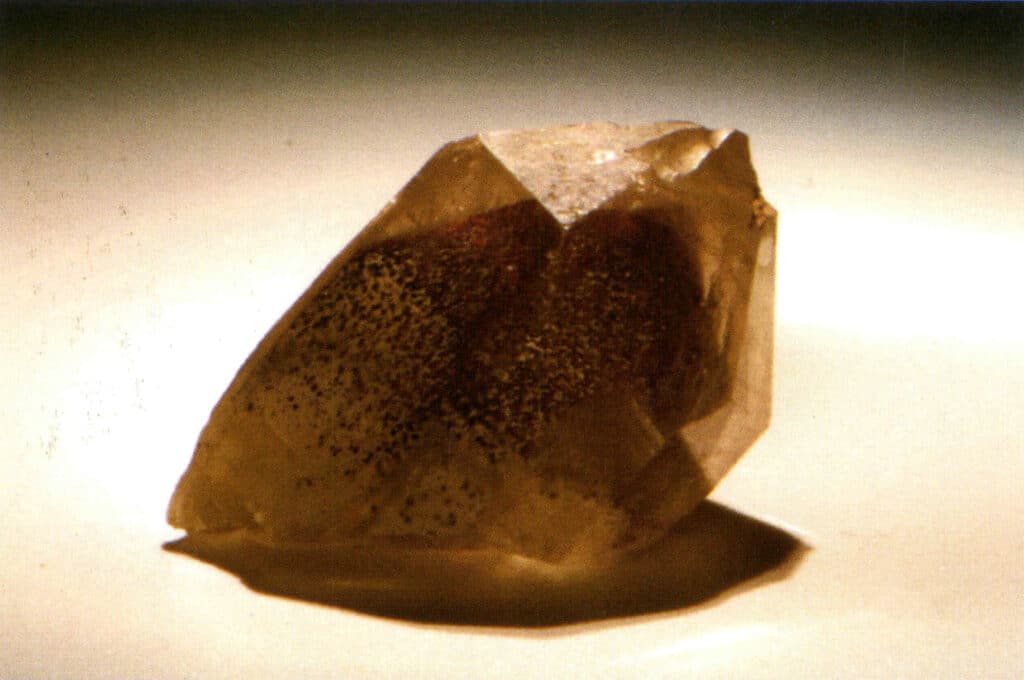
Figure 1-1-3 Crystal inclusions in crystals
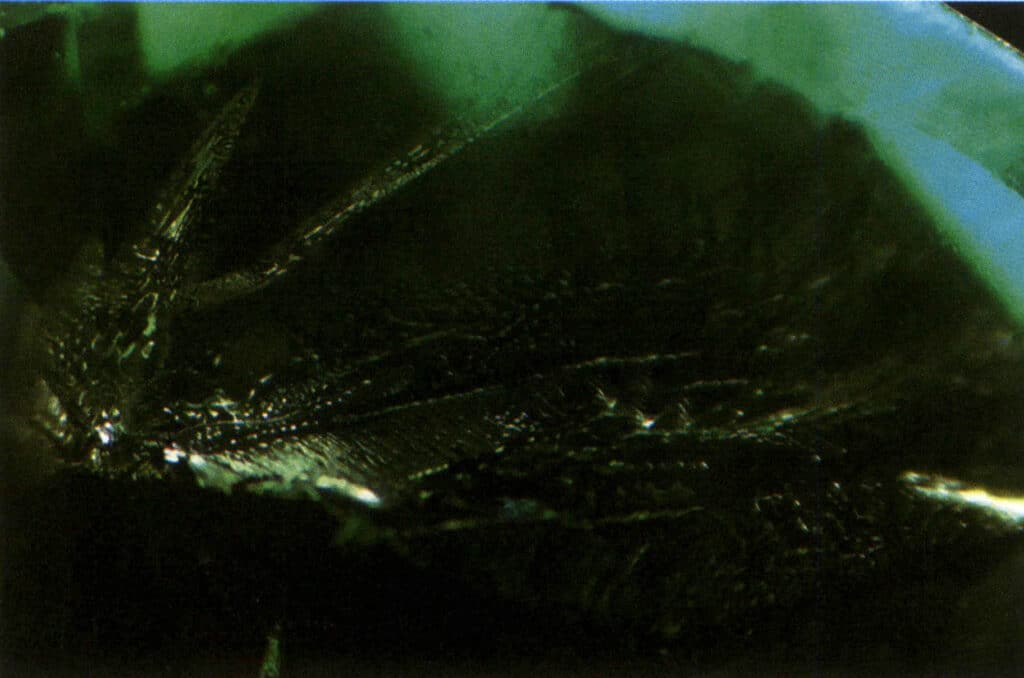
Figure 1-1-4 Synthesis of emerald internal fluid inclusions using flux method ( 40X, dark field illumination method)
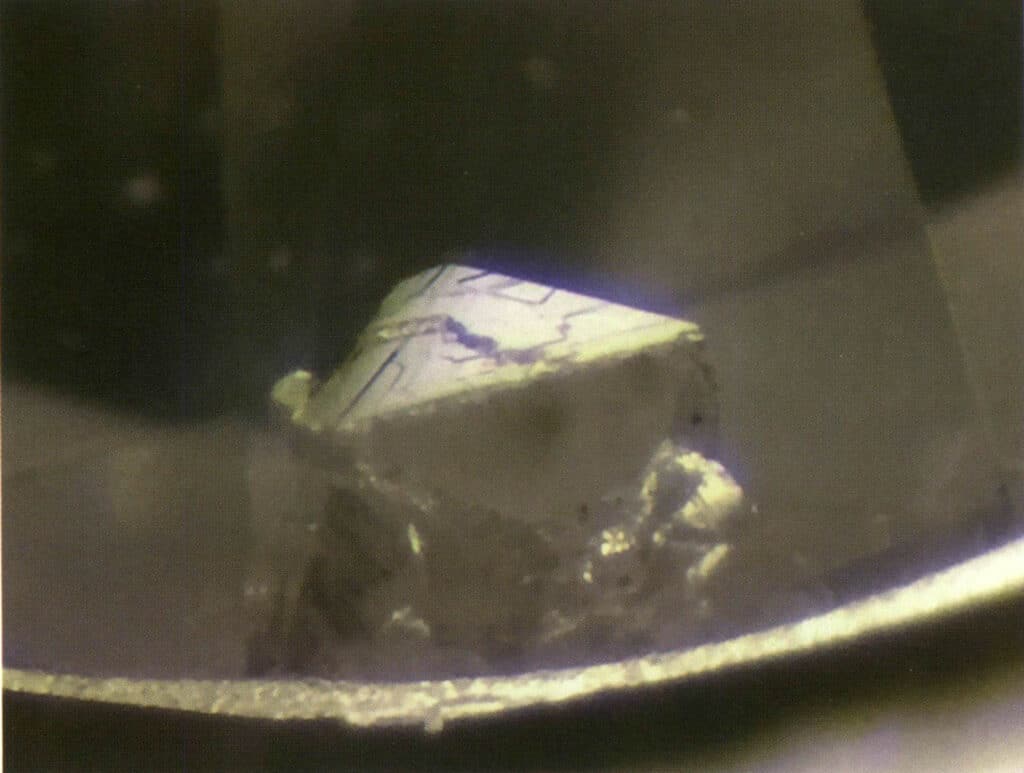
Figure 1-1-5 Vapor phase inclusions (diamond negative crystal within diamond, dark field illumination method, 40X)
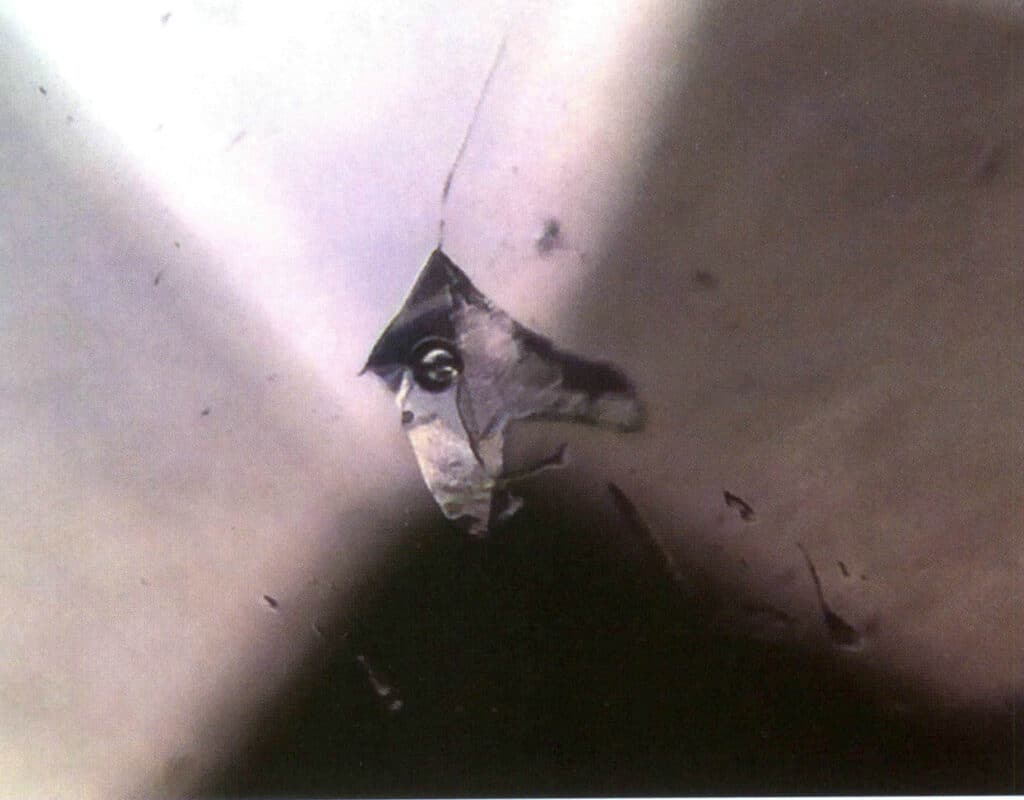
Figure 1-1-6 Gas-liquid two-phase inclusion (Topaz, dark field illumination method, 40X)
2. Non-material inclusions
Inclusions related to the crystal structure of the gemstone. For example, growth lines, color bands (Figures 1-1-7, 1-1-8), twin, cleavage, parting, fissures (Figures 1-1-9, 1-1-10), optical phenomena or pseudomorph, etc.
With the development of technology, the appearance differences between artificial and natural gemstones are becoming smaller and smaller. The significance of inclusions in gemology is also becoming increasingly important. The types, compositions, combinations, and characteristics of inclusions in gemstones can reflect the material sources, thermodynamic conditions, specific artificial environments, or geological environments at the time of gemstone formation. Research on gemstone inclusions helps to identify the naturalness of gemstones, evaluate their quality, understand their properties, determine their origin, and infer their genesis.
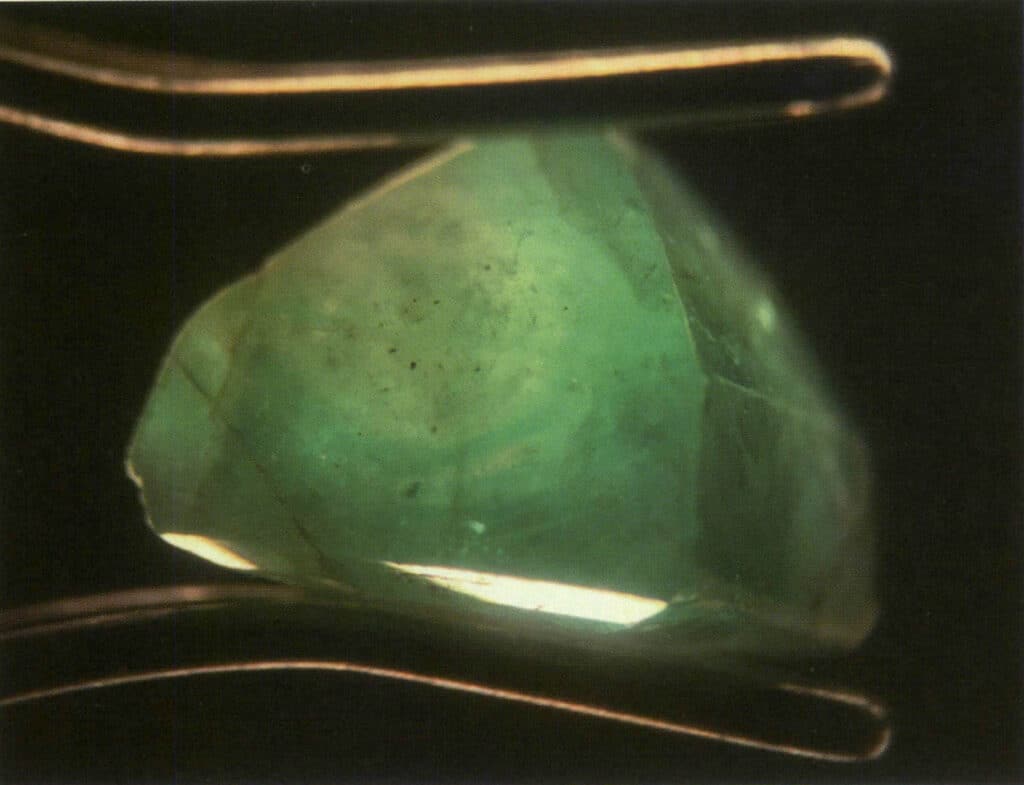
Figure 1-1-7 Emerald Hexagonal Ribbon
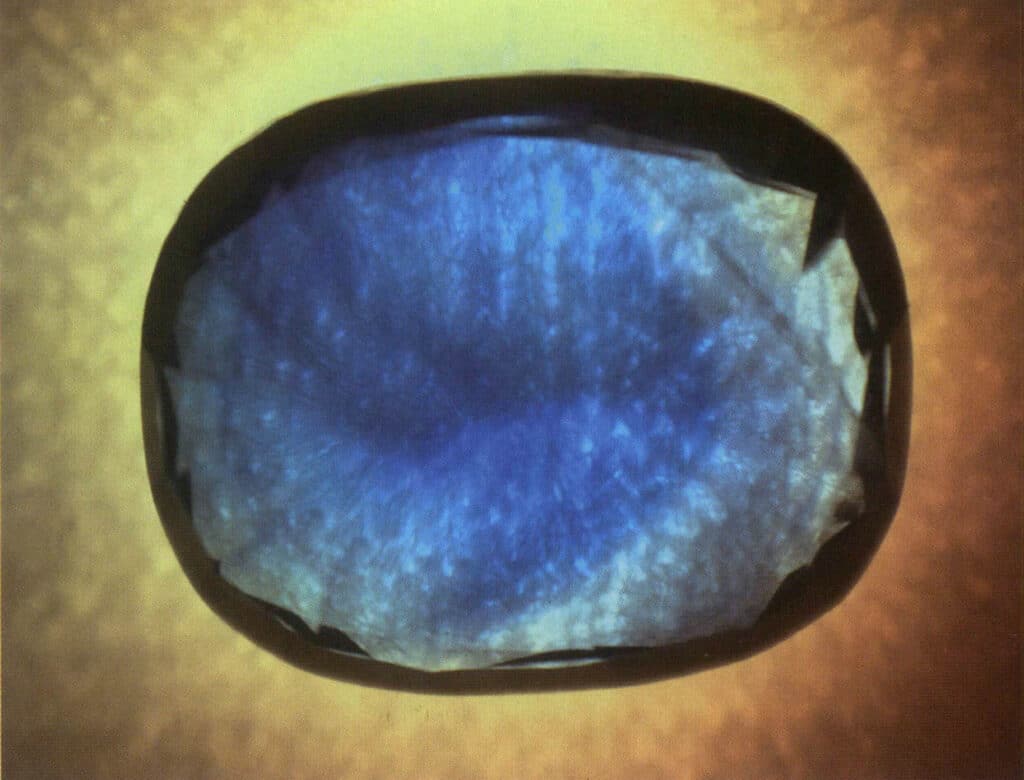
Figure 1-1-8 Sapphire angular color band

Figure 1-1-9 Internal linear cleavage of fluorite

Figure 1-1-10 Internal cracks in amber
Copywrite @ Sobling.smycken - Anpassad smyckestillverkare, OEM och ODM smyckesfabrik
Section IV Naming Rules for Gemstones
For consumers, due to the lack of systematic training in gemstone observation and data analysis, the only valid evidence that can confirm the type and naturalness of gemstone materials is the gemstone appraisal certificate, so they need to judge the legitimacy of gemstone appraisal certificates, and to understand the meaning of the gemstone designation on the gemstone appraisal certificate.
1. Naming of Gemstones
1.1. Natural Gemstones
Directly use the basic name of natural gemstones or their mineral names without adding the word “natural.”
- The place of origin does not participate in name, such as: “South African Diamond,” “Myanmar Sapphire,” etc.
- It is prohibited to use a combination name of two or more natural gemstones to name a certain gemstone, such as: “Ruby Spinel,” “Alexandrite Sapphire,” etc., except for “AlexandriteCat’s Eye.”
- Prohibit the use of ambiguous commercial names, such as: “Blue Crystal,” “Green Gem,” “Semi-precious Stone,” etc.
1.2. Natural Jade
Directly use the basic name of natural jade or its mineral (rock) name, and the word “Jade” can be added after the natural mineral or rock name without needing to add “Natural.” Except for “Natural Glass.”
- Do not name natural jade based on carved shapes.
- “Jade” or “jade stone” cannot be used alone to directly replace specific names of natural jade.
- The basic names of natural jadewith geographical names do not have the meaning of origin.
1.3. Naming of artificial products
Artificial gemstones are named by adding “artificial” before the material name. For example: “artificial undue aluminum garnet,” etc.
Synthetic gemstones are named by adding “synthetic” before the material name. For example: “synthetic diamond,” etc.
Reconstructed gemstones have the word “reconstructed” added before the basic name of natural jewelry. For example: “reconstructed amber,” “reconstructed turquoise,” etc.
Composite stones have the words “composite stone” added after the name of the constituent material or have the word “composite” added before it.
- The names of the constituent materials can be written layer by layer, such as: “sapphire, synthetic sapphire composite “
- Only the main material name can be written, such as: “sapphire composite stone” or “composite “
1.4. Imitation gemstones
- Add the word “imitation” before the basic name of the natural gemstone being imitated.
- When determining the specific name of the imitation gemstone, all naming rules specified in this standard should be followed.
- The specific name of the gemstone should be determined as much as possible, and the following representation should be used, such as: “glass” or “imitation crystal (glass),” etc.
- The term “imitation gemstone” should not be used alone as the name of a gemstone.
- Using “imitation of a certain gemstone” to indicate the name of the gemstone means that the gemstone is not the gemstone being imitated (for example: “imitation diamond” is not a diamond), and the materials used can vary (for example: “imitation diamond” could be glass, synthetic cubic zirconia, or crystal, etc.).
1.5. Naming of gemstones with special optical phenomenon
- For gemstones with cat’s eye effect, add the words “cat’s eye” after the basic name of the gemstone. Only “cat’s eye chrysoberyl” can be called “cat’s eye.”
- For gemstones with star effect, add the words “star” before the name of the gemstone. Add the words “synthetic star” before the corresponding natural gemstone’s basic name for synthetic gemstones with star effect.
- For gemstones with color change effect, add the words “color change” before the basic name of the gemstone. For synthetic gemstones with color change effect, add the words “synthetic color change” before the corresponding natural gemstone’s basic name.
- Other special optical phenomenon, excluding star effect, cat’s eye effect, and color change effect, are not included in the naming and can be noted in relevant quality documents. Note: the sandstone effect, halo effect,play of colour, etc.; all belong to other special optical phenomenon.
1.6. Optimization of Gemstone Naming
Optimized gemstones directly use the names of jewelry and gemstones, and specific optimization methods can be noted in the relevant quality documents.
There are four points to note when processing gemstones:
- Indicate the basic name of the jewelry and gemstones:
(a). Add specific processing methods before the name, such as diffusive sapphire, Bleached and polymer impregnated jadeite.
(b). Add the processing method in parentheses after the name, for example, Sapphire (diffusion) or Jadeite (bleaching, filling).
(c). Add the word “processing” in parentheses after the name, and you can include a note in the relevant quality documents to specify the processing methods, for example: Sapphire (processing), Jadeite (processing).
- For gemstones whose treatment status cannot be determined, it may not be indicated in the name. However, it should be noted in the relevant quality documents as “may have been treated” or “itcannot be determined whether it has been ××”
- Gemstones treated by multiple methods should be named according to A or B above. For example: If a diamond’s color has been treated by irradiation and high-temperature high-pressure treatment, itshould be named “Diamond (treatment)” with a note stating “irradiation treatment, high-temperature high-pressure treatment” or “diamond color treated artificially.”
- Processed artificial products can be directly named using the basic name of artificial products.
2. Naming of jewelry and gemstone accessories
Jewelry and gemstone accessories are named according to the gemstone name + accessory name. The gemstone name is determined according to the corresponding naming rules in this standard, and the accessory name is determined according to the provisions of QB/T1689. For example:
Non-inlaid jewelry and gemstone accessories can be directly named using the gemstone name or named according to the gemstone name + accessory name, such as: “Jade” or “Jade Bracelet.”
Accessories made of multiple gemstones can be named for each material, such as: “Tourmaline, Garnet, Crystal Bracelet.”
Name it according to its main jewelry gemstone name, followed by the word “etc.” but other names should be noted in the relevant quality documents. For example: “Tourmaline etc. bracelet” or “Tourmaline, garnet, etc. bracelet” should be annotated to explain “Tourmaline, garnet, crystal.”
Jewelry and gemstone accessories inlaid with other metal materials can be named according to the metal material name + gemstone name + accessory name.
Section V The Hallmark of Precious Metals
The regulations on precious metal hallmarks in China’s national standard GB11887-2012, “Jewellery – Fineness of precious metal alloys and designation”, are as follows.
1. Naming Rules for Precious Metal Jewelry
The naming content for precious metal jewelry can only include purity, material, gemstone names, and types of jewelry. No other content is allowed before or after the name.
Example 1: 18K Gold Ruby Ring
Example 2: Pt900 Diamond Ring
2. Jewelry Product Marks (Jewelry product marks include stamps and labels)
2.1. Content of the mark
The content of the mark should include manufacturer code, material, purity, and the quality of the main diamond in diamond-set jewelry (over 0.10 carats). For example, the mark for a jewelry set with a 0.45-carat diamond made by Beijing Filigree Inlay Factory is Jing A 18K gold 0.45ct D.
2.2. Method of indicating purity marks
The main body is printed according to the provisions of Table 3, and the accessories are marked according to the provisions of “Three.”
① Gold jewelry: purity parts per thousand (in carats) and a combination of gold, Au or G. For example, Gold 750 (18K gold), Au 750 (Au 18K), G 750 (G 18K).
② Platinum jewelry: a combination of purity parts per thousand and platinum (platinum, white gold) or Pt. For example: platinum (platinum, white gold) 900, Pt900.
③ Palladium jewelry: a combination of purity parts per thousand and palladium (palladium) or Pd. For example: palladium (palladium) 950, Pd950.
④ Silver jewelry: purity parts per in thousand and combinations of silver, Ag, or S. For example, Silver925, Ag925, S925.
⑤ When jewelry is made from different materials or purities of precious metals, the materials and purities should be indicated separately.
⑥ When jewelry cannot be stamped due to being too fine or small, a label containing the stamp content should be attached.
2.3. Label product content
The product label should indicate the Chinese characters, for example, Platinum 950 or Platinum Pt950.
3. The purity range of precious metals and their alloys (Regulations on the purity of precious metal jewelry)
Purity is a minimum value and must not have a negative tolerance. The purity range of precious metals and their alloys is shown in Table 1.
Table 1: Purity ranges of precious metals and their alloys
| Precious metals and their alloys | Purity minimum value in parts per thousand ‰ | Other representations of purity |
|---|---|---|
| Gold and its alloys | 375 | 9K |
| 585 | 14K | |
| 750 | 18K | |
| 916 | 22K | |
| 990 | Rent guld | |
| Platinum and its alloys | 850 | - |
| 900 | - | |
| 950 | - | |
| 990 | Pure platinum, pure platinum, pure platinum gold | |
| Palladium and its alloys | 550 | - |
| 950 | - | |
| 990 | Fine palladium, fine palladium gold | |
| Silver and its alloys | 800 | - |
| 925 | - | |
| 990 | Fine silver |
Note 1: The theoretical value of 24K is 1000‰ .
Note 2: “Fine (gold, platinum, palladium, silver)” is the highest purity of jewelry products specified in this standard, referring to a precious metal content of no less than 990‰
4. Purity regulations for jewelry accessory materials
The purity of accessory materials should be consistent with the main body. Due to the requirements of strength and elasticity, accessory materials should meet the following regulations:
① For gold jewelry with a gold content of 916‰ (22K), the gold content of its accessories must be at least 900‰ .
② The platinum content of platinum jewelry must not be less than 950‰ , and the platinum content of its accessories must not be less than 900‰ .
③ The palladium content of palladium jewelry must not be less than 950‰ , and the palladium content of its accessories must not be less than 900‰ .
④ The silver content of sterling silver and pure silver jewelry must be at least 925‰ .
5. The elements in precious metals and their alloys must not harm human health.
5.1.The content of harmful elements such as lead, mercury, cadmium, hexavalent chromium, and arsenic in jewelry must be less than 1‰ .
5.2. Nickel-containing jewelry (including non-precious metal jewelry) must comply with the following regulations.
① Products removed or retained during the healing process of piercings in the ears or any other body part must have a nickel release rate of less than 0.2 micrograms / ( cm²・ week).
② Products that have long-term contact with human skin, such as earrings, necklaces, bracelets, bangles, anklets, rings, watch cases, watch bands, watch clasps, snap fasteners, buckles, rivets, zippers, and metal tags (if not attached to clothing).
③ The nickel release rate of these products in parts that have long-term contact with the skin must be less than 0.5 micrograms / (cm² ・ week).
④ For the specified products, if there is a coating on the surface, the coating must ensure that the nickel release amount is less than 0.5 micrograms / (cm²- weeks) during normal use for two years in contact with the skin.
⑤ Products must not meet the requirements to enter the market.
Section VI Certificate of Gemstones
1. Certification of gemstone identification certificates
As of 2014, more than thirty jewelry identification institutions in China have the qualification for jewelry identification and testing. The identification certificates or reports issued by these institutions must obtain CMA certification according to national requirements, and these institutions can choose CAL or CNAS certification based on their own needs.
1.1. CMA Accreditation
CMA stands for China Metrology Accreditation, a mandatory legal assessment by the state for testing institutions. It is the formal recognition given by government authorities for specified types of testing conducted by these institutions. The basis for metrology accreditation is the “Metrology Law of the People’s Republic of China.”
1.2. CAL Accreditation
CAL stands for China Accredited Laboratory, an administrative approval system implemented by the state for quality inspection institutions and authorized national and provincial quality inspection centers that undertake supervisory and arbitration inspection tasks. The basis for review and recognition includes laws and regulations such as the Standardization Law of the People’s Republic of China, Regulations for the Implementation of the Standardization Law of the People’s Republic of China, and the Product Quality Law.
According to the “China Inspection Body and Laboratory Mandatory Approval Criteria” issued by the General Administration of Quality Supervision, Inspection and Quarantine of the People’s Republic of China and the Certification and Accreditation Administration, since 2007, metrology accreditation and review recognition have been unified into laboratory qualification accreditation. Only laboratories that have passed qualification accreditation can use the metrology certification and review recognition marks on their inspection reports. Inspection reports with CAL and CMA marks can be used for product quality evaluation, results, and judicial identification and have legal effect. CMA/CAL certification is implemented at two levels: by the Certification and Accreditation Administration and by Provincial Quality and Technical Supervision Administration.. The certification numbers issued by the Certification and Accreditation Administration have the character “国” (Guo). In contrast, those issued by Provincial Quality and Technical Supervision Administration have the abbreviation of the respective province, municipality, or autonomous region.
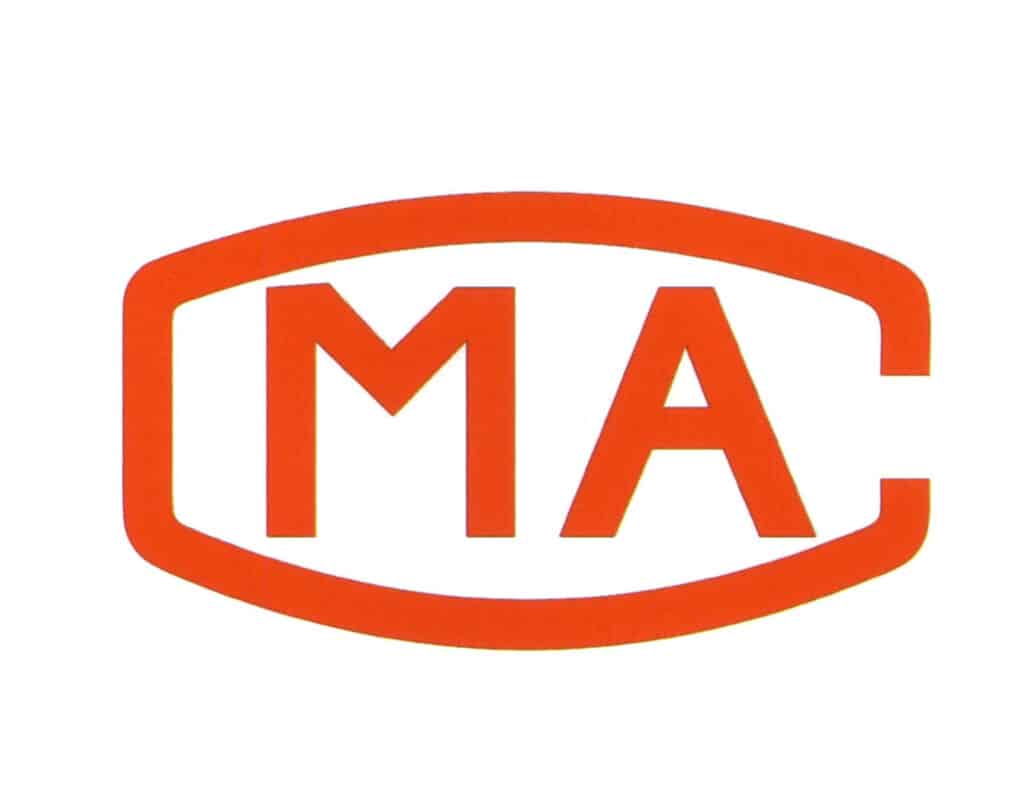
Figure 1-2-3 CMA mark

Figure 1-2-5 CAL mark
1.3. CNAS Accreditation
CNAS stands for China National Accreditation Service for Conformity Assessment. It is a national accreditation body established and authorized by the Certification and Accreditation Administration according to the provisions of the “Regulations of the People’s Republic of China on Certification and Accreditation,” responsible for the accreditation of certification bodies, laboratories, and inspection agencies. It supervises and manages the accredited conformity assessment bodies and permits the use of the accreditation committee’s logo and accreditation marks.
1.4. ILAC-MRA Accreditation
“ILAC” is the abbreviation for the International Laboratory Accreditation Cooperation, and “MRA” stands for Mutual Recognition Arrangement (Figure 1-2-8).
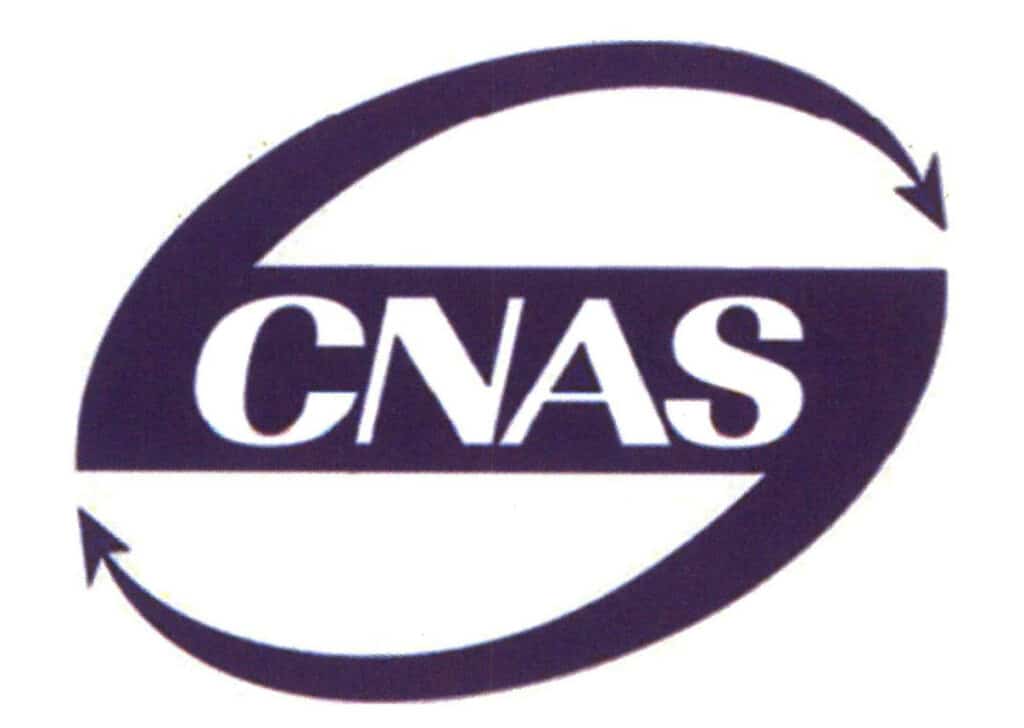
Figure 1-2-7 CNAS mark

Figure 1-2-8 ilac - MRA mark
2. Gem Identification Certificate Analysis
— Taking the Diamond Inlaid Sulfur Grading Identification Certificate from the National Gemstone Testing Center as an example.
In China, the authoritative organization, the National Gemstone Quality Supervision and Inspection Center (NGTC), has issued four types of identification certificates for diamonds and diamond-inlaid products, namely the “Inlaid Diamond Grading Identification Certificate,” “Gemstone Identification Certificate,” “Diamond Grading Certificate,” and “Diamond Grading Report.”
The “Inlaid Diamond Grading Identification Certificate” is a relatively common certificate among inlaid diamond products , mainly including:
Certificate number: The identification certificate number of this jewelry so that consumers can check the certificate’s authenticity online.
Inspection conclusion: Describes the type of diamond jewelry. If it is a natural diamond, it will be marked as “diamond” in the inspection conclusion; if it is a synthetic or treated diamond, it will be marked as “synthetic” or “treated” in the inspection conclusion.
Total weight: Describes the total weight of the diamond jewelry. Since the diamonds in the set products are embedded in metal, it is impossible to accurately measure the weight of the diamonds; the certificate will indicate the total weight of the jewelry.
Shape: Describes the shape of the diamond.
Color: Describes the color grade of the diamond according to national standards.
Clarity: Describes the clarity grade of diamonds according to national standards.
Table Width Ratio: Describes the ratio of the table to the diameter in the diamond’s cut.
Pavilion Depth Ratio: Describes the ratio of the pavilion depth to the diameter in the diamond’s cut.
Precious Metal Testing: Describes the metal materials used in diamond jewelry.
Remarks: Descriptions of other diamond characteristics not mentioned in the report, specific treatment methods for processed gemstones.
To ensure the certificate’s authority, fairness, and authenticity, the National Gemstone Testing Center not only prints a fluorescent anti-counterfeiting mark on the certificate but also provides two numbers for consumers to verify the authenticity of the certificate online. Consumers can log on to the official website of the National Gemstone Testing Center(www.ngtc.com.cn) or the China Jewelry Industry Network (www.chinajeweler.com) to check the authenticity of the certificate.







